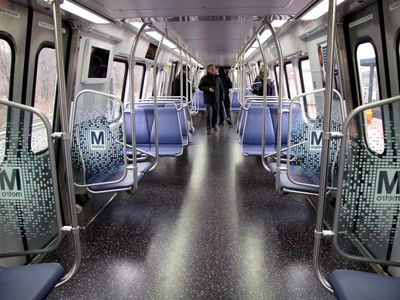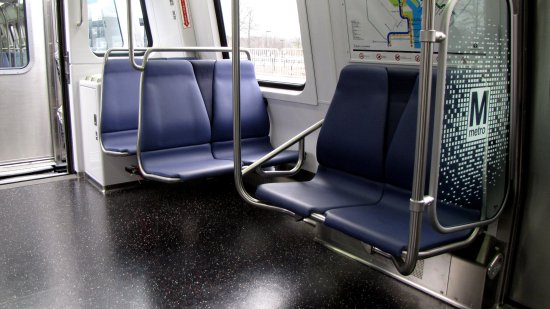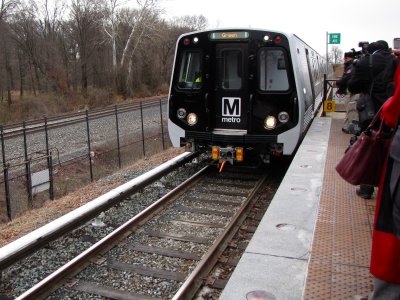On Monday, January 6, at 10:30 AM, the future of Metro arrived, as Metro debuted its new 7000-Series railcars for the press at Greenbelt station. First thing that happened is that they brought the train into the station:
Once the train stopped in the station, the last set of doors on the trailing car (7006) opened, and out stepped Metro General Manager Richard Sarles to greet everyone. As the train had come in signed as a Green Line train to Branch Avenue, the new canned announcements were running. I only heard two: the line announcement and the door open announcement. The voice is female, but it’s not Randi Miller, whose voice currently makes Metro’s door announcements. The new voice is higher in pitch than Miller’s. The door announcement, while in a different voice, is otherwise still the same: “Doors opening! Step back to allow customers to exit. When boarding, please move to the center of the car.”
The mainstream press then took the opportunity to tour the cars, while various local officials made remarks about the new railcars, beginning with Sarles:
Sarles was followed at the podium by Senator Barbara Mikulski:
By the time that Senator Mikulski had finished her remarks, most of the mainstream media had finished its tour of the train, and there was enough space for me to tour. Therefore, I present to you, the new 7000-Series railcars:

Car 7007, viewed from just past the end doors, facing the blind end of the car. The seat layout is different than before, with more side-facing seats, and two less rows of seats in the middle of the cars.

Blind end of car 7007. Like in the existing fleet, there is no cab at this end of the car. The seats themselves are a departure from the current fleet. Unlike how they appeared in the concept drawings, this design pleases me. The seats appear as a unified piece while still showing two distinct seats. It’s because the piece between the two seats comes all the way up (and has the Metro logo on it!). Like the existing fleet’s seats, the bar runs along the entire top of the seat, and there is a vertical pole attached to most seats, similar to the 6000-Series. Additionally, these new seats have a more ergonomic design. Sitting in these new seats, I noticed the higher back, and also far more lumbar support than before.
The back of the new seats is a significant departure from the existing fleet. Because of the additional lumbar support, there is an added bonus: more legroom!
Like in other car series, where there is a seat adjacent to a door, there is a windscreen. Unlike the 1000 through 5000-Series, these new windscreens are not full-height, and unlike the 6000-Series, this windscreen is both off the floor and higher than head height for the average seated passenger.
The floor is not carpeted and primarily black, with red, white, and blue flecks in it for a slightly patriotic touch. The designated wheelchair area next to the center doors, similar in size to the 6000-Series cars, is marked out on the floor in blue.
The new interior LEDs can display larger text than before, and use orange text rather than red (though at least the 6000-Series is capable of showing other colors). Unlike the 6000-Series, there is nothing like this in the center of the cars, though this is made up by other devices. During the display, the sign alternated between “Next stop is” and “College Park”. I don’t know if this particular style of message is just for station stops, or if there are other messages as well.
Electronic strip map. This is over the middle window on one side of each half of the car, where a spot for signage exists on other cars. It lists the next six stops, then four more stops of varying distances, and then the final station on the line. The map is shown displaying the stops for Green Line service to Branch Avenue.
This is a completely new feature on the 7000-Series cars. This is an LCD screen showing service information, replacing the system map on the evacuation instructions sign.
The doors are more or less the same as on older railcars, though a bit shinier than before.
Emergency instructions, door release handle, and center intercom. This version of the evacuation sign is completely new, and unlike past versions, has no system map.
The graphics for the door release handle are carried directly over from the earlier evacuation maps. Note that the evacuation handle shown is the style used on the 1000-Series cars. Considering that the 7000-Series will replace the 1000-Series cars, and the other car series use a different style and color of door release handle, I hope that this graphic is updated on the final version of this sign before more cars are outfitted with it. I can almost guarantee that this was an oversight, but it will be an obsolete illustration following the retirement of the 1000-Series cars.
The door release handle is similar to that on other car series (other than the soon-to-be-retired 1000-Series). The major difference from others is that this has a shiny surface, rather than a brushed appearance.
The emergency intercoms, shown here at the coupler end of car 7007, are now steel rather than plastic. The red button now has a light in the center of it. The car number is located adjacent to the intercom unit.
This is the coupler end of car 7007. In older car series, a cab would be located in this area. Since the 7000-Series runs in sets of four cars rather than two, this is similar to the other end of the car.
There is likely some sort of equipment concealed in this corner, and I have no idea what this area contains. The bars on top of this area lead me to think that this may also be intended as a place to put luggage.
I believe that this cabinet next to the door contains a set of hostler controls to allow 7000-Series pairs to be moved in the yard from the coupler end when not in a full quad set.
This is the cab end of car 7006. Note that the large window in the cab is now gone, and understandably so – it is my understanding that the large windows looking towards the interior of the car caused a lot of glare in the cab. While the normal railfan window has been eliminated, there is a view through the cab door window.
Operator’s console in the cab. The large screen in the middle and the smaller screen to the right are new, and a number of the train controls are in different places than before.
The control handle, previously on the console itself, is now against the right-side wall.
Door and coupling controls on the right-side wall. The “reopen doors” button is new, and the train sign information is missing from this area. I would assume that the sign information has been relocated to a different part of the cab, but I did not see any designated area for it. This may mean that it’s on one of the two screens and no longer has any dedicated physical hardware in the cab.
Breaker switches, behind the operator’s head, as in the 6000-Series cars.
Left-side door switches, emergency stop plunger, and PA microphone. Unlike in previous car series, the controls are not behind a door, and this area contains no seat, and will most likely be unavailable to passengers.
The fronts of the new 7000-Series cars are black, and contain the Metro logo on the door.
The carbodies are stainless steel, rather than aluminum as used in older car series, and are corrugated at the bottom. The windows are less rectangular. In addition, the external speakers are lower than before, and there are two destination signs per side.
Blind end between 7004 and 7005. Based on what I observed here, the even-numbered cars contain the full cabs, and the odd-numbered cars contain the hostler controls. Similarly to the current cars as retrofitted in the late 2000s, the car numbers are in large size on both ends of the car near the roof.
And then when the event was over, they brought the car back to the yard:
And that’s the 7000-Series! As I understand it, since these are the first cars to arrive for acceptance testing before Kawasaki goes into full production on these cars, some of the details may be subject to change. I would also take the acceleration sounds that are in the video of the departure with a grain of salt due to the low speed of these movements.
Meanwhile, I’m excited. These new railcars are going to be really neat, plus this finally resolves the concerns about the structural integrity of Metro’s oldest railcars, which have a tendency to fail catastrophically in a collision. I am definitely looking forward to seeing these new railcars enter service once acceptance testing is complete and full-scale production begins.
Lastly, I would like to take a moment to thank Metro General Manager Richard Sarles, Metro spokesman Dan Stessel, Metro’s media relations staff, and all of the other Metro employees involved in this event for their hospitality and helpfulness during this event.
